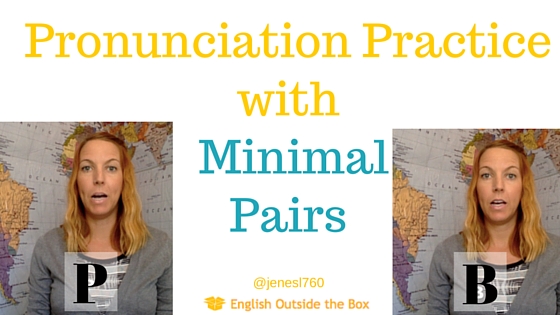
American English Pronunciation: P vs B
There is a lot of work needed to improve and perfect your pronunciation skills as an English learner. There are the basic steps of understanding sounds in the alphabet and learning how to accurately produce these sounds in order to form words. When you get comfortable with this, you can move into the more complex area of pronunciation and look at linking sounds, connecting words, intonation, rhythm and other speech patterns. All of these areas are important in your overall pronunciation skills; however, it’s important to build a strong foundation in your pronunciation before you move on to the more complicated areas. You want to make sure you have a solid understanding and accurate use of the basic steps before learning more. I mean you wouldn’t start studying the 3rd conditional if you didn’t understand the simple past tense, right?
That is why, today, I am bringing you back to the basic steps of pronunciation, and we are going to look at some individual sounds in American English pronunciation. The individual sounds will be P and B in American English, how they are different, similar, and most importantly, how to pronounce them correctly. These are commonly confused and often pronounced incorrectly, especially by native Arabic speakers because the P doesn’t exist in this language. Other native languages that have shown difficulty are Persian, various Indian dialects (Hindi, Telugu, etc..), and sometimes Korean, just to name a few.
So are you ready to master the P and B pronunciation in English?
You can start this lesson with this week’s 5 Minute English video to practice some listening comprehension and see how these sounds are made. By watching this video, you’ll be able to watch my mouth in order to understand how you should look when practicing the sounds and words. Pay attention to the information in this video, and when you’re finished, come on back here to the blog to read more and get some additional practice.
Let’s review what we heard in today’s video: P and B American English Pronunciation
The examples you heard in today’s video were:
P like in the words: pear and cup
B like in the words: bear and cub
You can see the similarity in the words above:
pear and bear
cup and cub
These pairs of words are called minimal pairs
What are minimal pairs in English?
Minimal pairs are words in English that are exactly the same except for 1 differing sound. This differing sound (P and B in today’s lesson) can cause confusion in English learners because they often mix up the words causing misunderstanding when speaking and having conversations. Today’s lesson will help you stop this misunderstanding and confusion.
How do you make the P and B sounds?
The way to make the sounds are the same, your lips come together (and curl inward) and you blow out air. The difference is that one sound, the P is voiceless and the other sound, B is voiced.
Voiceless sounds are sounds that do not cause your vocal chords to vibrate in your throat. Conversely, a voiced sound creates that vibration that you can actually feel when you hold 2 fingers up to your throat. Try it!
Produce the voiceless sound while holding your fingers on your throat: P should produce just a puff of air and absolutely no vocal chord vibrations. Try it a few times before moving on to the B sound. Remember, you will feel a vibration in your throat with B. Even though the mouth position is the same, producing the B requires you to produce the voiced/vibrating sound.
In order to practice and really understand these sounds, it’s necessary to do repetitive exercises to build up muscle memory (to remember how you make the sounds) and get completely comfortable with the differences.
How can you practice and become a pronunciation super star?
Practice by first repeating the sounds, and then alternating the sounds (*switching from 1 sound to the other*) to really feel, hear, see, and understand the differences.
As I mentioned in the video, once your comfortable with the individual sounds, it’s time to move onto the words. Always begin practicing 1 focused sound. After a few repetitive exercises, move onto the other sound. Once you’ve practiced the sounds individually, begin with the alternation to practice the two together.
In the video, I give you ‘pear’ and ‘cup’ for the focused P words, and ‘bear’ and ‘cub’ for the focused B words. Here are some other words that you can practice:
pie, pill, pace, pride, lip, rope, cap, peep
buy, bill, base, bride, lib, robe, cab, beep
First repeat the P words individually, then the B words, and finally alternate them: pie | buy, pill | bill, pace | base, and so on…
Let’s take a moment to make sure you are saying these words correctly.
Think about and answer these questions:
- do you hear a difference in the 2 sounds/words when you say them?
- can you feel the vocal chords moving for B and not moving for P?
- does your mouth position look the same as mine when you’re pronouncing these words? (use a mirror or record yourself!)
If any of these answers are “no” then you need to continue reviewing the individual sounds before moving on with the video’s exercises. If you have any questions, please comment below or send me a message. If you want to meet with me to practice pronunciation, then you can always sign up for an online lesson via Skype. Click here for more details.
If you answered “yes” to all of the questions above, then great job! Continue with the video’s exercises and this blog article for more practice with complete sentences.
Sentence practice with the P and B sounds in American English
In the video, you received the following sentences to practice:
The pear is on the cup. (focused P)
The bear is on the cub. (focused B)
The cub has a cup. (alternating B and P)
The bear has a pear. (alternating B and P)
Here are a few more sentences using the extra word examples from above:
I put a pie, pill, and rope in my cap. (focused P)
I put a bill and robe in my cab. (focused B)
The bride made a peep (alternating B and P)
The pride made a beep (alternating P and B)
Okay, so you have individual sounds, words, and sentences to practice and perfect the P and B in American English pronunciation. You have a 5 Minute English video lesson to practice listening and to see how the sounds/words look, as well as this blog post with additional examples and practice sentences. You have a lot to practice and I hope it helps you feel more confident in your English skills.
I invite you to show off your skills, comment below with your progress, are you feeling confident with the P and B? Do you have additional words and sentences you would like to add? Help others learn by sharing this information in the comments.
You can also share this page with a friend or colleague, help them and help me! Thank you!
Most importantly…
Happy Studying! ♥
The Conversation Club will provide you with 6 group conversation calls to practice with a real teacher and a group message community to connect with other members.
You will also get weekly English lessons to help your vocabulary, listening, reading, pronunciation, and more!
Try the Club for 1 week, free! Join the 1-week free trial here.

Excellent information, I would recommend an application that has helped me to learn English. I hope it will be useful for all
https://play.google.com/store/apps/details?id=com.pronuntiapp